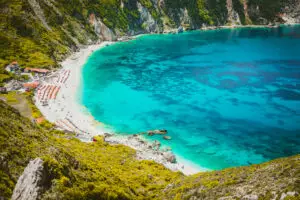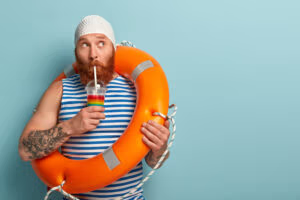Sailing the Dodecanese: Where the Gods Play Pranks
Rhodes: Where Ancient Knights & Windy Days Collide
First stop, Rhodes Greece, the largest of the Dodecanese Islands and home to the legendary Colossus—an ancient statue so big that, if it were still around, sailors would probably mistake it for a giant lighthouse (and then wonder why it didn’t work). Rhodes’ medieval charm and fortified harbor are a sailor’s dream, but don’t let those towering walls intimidate you. Just be grateful that the Knights of Rhodes aren’t around to critique your docking skills. Sailor joke time: Why don’t the knights of Rhodes sail anymore? Because they’re tired of jousting with the wind!
Kos: The Island Where Medicine Meets Mythology
Next up, Kos – the birthplace of Hippocrates, the father of medicine. So if you happen to get a sunburn while lounging on deck, rest assured you’re in good hands (or at least in the vicinity of some ancient medical wisdom). The winds around Kos Greece can be as temperamental as a Greek god who skipped breakfast, so keep your wits about you! If your sails start to flap like a toga in the wind, don’t panic. Just remember that even Hippocrates probably had a few rough days on the water. Sailor joke: Why did the sailor visit Kos? He heard the winds could cure his “knot-tying” anxiety!
Symi: Where Colors and Confusion Reign
Sailing into Symi island is like entering a painter’s dream—a colorful harbor filled with pastel houses stacked up like a sailor’s deck of cards. The views are as stunning as they are distracting, which is probably why docking here can feel like an Olympian challenge. But once you’ve managed to anchor without bumping into someone’s fishing boat, you’ll understand why the gods spent so much time around here. Just be sure to wave at the locals—they love watching sailors try (and occasionally fail) to dock. Sailor joke time: Why don’t sailors in Symi play hide and seek? Because the harbor is too colorful to blend in!
Patmos: The Island of Saints and Silly Sailors
Patmos is famous for being the island where Saint John wrote the Book of Revelation, but don’t worry, your sailing trip won’t involve any apocalyptic waves, unless, of course, you forget to check the weather forecast. The island’s serene beauty is perfect for sailors who want to relax, reflect, and maybe even meditate on their next nautical misadventure. Just be careful where you drop anchor, rumor has it that even the saints here had trouble with the local winds. Sailor joke time: Why did the sailor visit Patmos island? He wanted to “revel” in its beauty—and hope his boat wouldn’t float away in the process!
Leros: Where Docking is an Ancient Art Form
If there’s one thing you’ll learn about Leros island, it’s that docking here is like trying to park a chariot in a crowded agora—tricky, but not impossible with a little patience (and maybe a prayer to Athena). Known for its picturesque harbors and laid-back vibe, Leros is the perfect place for sailors to practice their docking skills, whether you’re an expert or still figuring out which side is port. Sailor joke: Why don’t sailors in Leros get stressed? Because after a successful docking here, everything else feels like smooth sailing!
Kalymnos: The Island of Sponge Divers and Stubborn Winds
Kalymnos island is famous for its sponge divers, and if you thought diving for sponges was tough, try navigating the winds around this island! The locals have mastered the art of balancing on boats, but if you’re new to Kalymnos, be prepared for the wind to give you a run for your money. Just remember—every gust is a chance to improve your sail-trimming skills. And if you mess up? No worries, the sponge divers have probably seen worse. Sailor joke: Why do sailors love Kalymnos? Because even if you fall overboard, someone’s bound to dive in after you (or at least throw you a sponge).
Nisyros: Volcanoes, Villages, and Very Brave Sailors
Nisyros island is home to an active volcano, so if you’ve ever wanted to sail around an island that feels like it’s simmering with adventure, this is the place for you. Just be careful—those volcanic fumes can be tricky to navigate if you’re downwind! And while you’re here, take a break from sailing to hike around the volcanic crater—it’s one of the few times a sailor can say they’ve stood inside a volcano without their boat catching fire. Sailor joke: Why did the sailor love Nisyros? Because even the volcano knew how to “blow off steam” without losing its cool!
Tilos: Where the Giants of Greek Myth Still Roam
Sailing to Tilos island, you’ll feel like you’ve entered a land where myths and legends still walk among us. The island is famous for its dwarf elephant fossils, but don’t worry, you won’t run into any of those while navigating the waters. Tilos is peaceful, quiet, and the perfect place for sailors to anchor and enjoy a well-deserved break from the sea—just be careful not to disturb the local wildlife. Sailor joke: Why did the sailor visit Tilos? He wanted to see if the elephants had better docking skills than he did!
Astypalaia: The Butterfly of the Aegean
Astypalaia island is known as the “butterfly of the Aegean” thanks to its unique shape, but don’t let its delicate name fool you—sailing here requires a bit of finesse. The island’s harbors are small and charming, but they can also be a bit tricky to navigate if the winds decide to play games. However, once you’ve docked, you’ll find that Astypalaia’s beauty makes every sailing challenge worth it. Sailor joke time: Why do sailors love Astypalaia? Because even the winds here are “butterfly kisses” compared to other islands!
Conclusion: Sailing the Dodecanese – An Epic Journey of Laughter & Adventure
Congratulations, sailor! You’ve navigated the legendary Dodecanese Islands, where the winds are as unpredictable as the gods, the docking skills are put to the test, and the jokes just keep flowing like a well-stocked barrel of rum. Whether you’ve braved the winds of Kos, docked like a knight in Rhodes, or laughed at the sponge divers of Kalymnos, one thing’s for sure: sailing the Dodecanese is a journey filled with myths, laughter, and enough sailor stories to last you a lifetime. So, what are you waiting for? Grab your crew, set sail, and don’t forget—when in doubt, blame the wind!
Explore Greece by Sea with GrecoSailor: Personalized Itineraries for Every Traveler
– Explore the Magic of the Greek Seas, Your Way.
– Custom Sailing Itineraries Designed Just for You.
Contact Us Now to Create Your Dream Sailing Itinerary [email protected]




